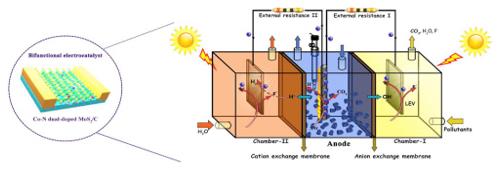
Focusing on the key issues of combining environmental purification with renewable energy conversion and utilization, a variety of nanostructured materials with different morphologies have been prepared. Through defect engineering on materials, the effect and mechanism of material micro surface lattice defects on materials have been explored. To a certain extent, the degradation of pollutants and the recycling of resources can be achieved by coupling nano structured materials with multiple technologies.
The principles and methods of improving the efficiency of catalysis and electricity generation by using a variety of coupling technologies are proposed, including photoelectric coupling, microbial photoelectric fuel cell coupling, piezoelectric coupling and optical fenton coupling. Based on a single chamber microbial fuel cell (SC-MFC), using FePO4 nanoparticles (NPs) as cathode catalyst instead of traditional Pt/C, a bioelectrochemical strategy was developed to build a simple and sensitive levofloxacin (LEV) sensor. FePO4 NPs greatly promoted the electrochemical oxidation of oxygen on the cathode, which helped to accelerate the voltage output of SC-MFC and provide a strong guarantee for LEV detection. FePO4 NPs were characterized by scanning electron microscopy (SEM), X-ray diffraction (XRD), Fourier transform infrared spectroscopy (FTIR) and X-ray photoelectron spectroscopy (XPS). Under the optimized COD condition (3mm), the LEV concentration range is 0.1-1000 μg/L, which can be successfully detected, and it shows a good linear range within the concentration range of 0-100 μg/L. Within this LEV concentration range, the anode of exogenic bacteria may be temporarily affected in less than 10 minutes, and then return to normal. It shows long-term stability and maintains stable power generation within 14 months of continuous operation. In addition, the density functional theory (DFT) is used to calculate quantum chemistry, and its detection mechanism is studied.

Adv. Funct. Mater. 2010, 20, 2165, IF = 18.808 , Top 1
Environ. Sci. Technol. 2012, 46, 4042 (ESI高被引论文) , IF = 9.028 , Top 1
Environ. Sci. Technol. 2010, 44, 5098 , IF = 9.028 , Top 1
Environ. Sci. Technol. 2009, 43, 858 , IF = 9.028 , Top 1
Journal of Power Sources, 2020, 478: 228755, IF = 9.127; Top 1
Sep. Purif. Technol. 2009, 67, 135
Nano Energy, 2021, 89: 106349., IF = 17.881; Top 1
Nanoscale, 2019,11, 22042-22053, IF = 7.79; Top 1
J. Mater. Chem. 2011, 21, 18067
Appl. Phys. Lett. 2009, 95, 093108
Langmuir 2011, 27, 3113;ACS Omega 2019, 4, 2, 4113–4128
Angew. Chem. Int. Ed. 2014, 54, 10485